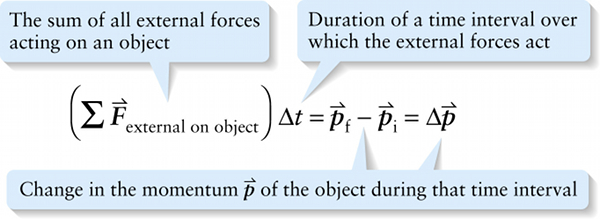Chapter 7. External force and momentum change for an object (7-23)
Question
TZhMbmbo8T+wYvHwn2Jmw+onDR4rlGwhex+u29+UpBeT1vURTwQwIbqHfh5WADjzt9je/SEiVYI=Question
P+t0T4fB+PcLcQrVKumMVxqGQQIkjqS3fKHK4aY+Y/+eGlp2LovU6zmf7NY/VTdK8OiVAIgKwJDSPgCbpum8vford+Q=Question
R4QTozr0IuCRAAa4qKdw36mUCwBN+83L6MDlZPNOIc+Mau0EyQg8Fw9zhKkGhnEu6PrzF5qHlpm8f9rzrWe+GiIXAfvvjKd2aaRG3Q==Review
We learned in Section 7-3 that if external forces act on a system of objects for a time \(\Delta{t}\), the result is a change in the momentum of the system from an initial value \(\vec{P}_i\) to a final value \(\vec{P}_f\). This change is given by Equation 7-13: \(\left(\sum{\vec{F}_\mathrm{external\ on\ object}}\right) \Delta{t} = \vec{P}_f - \vec{P}_i\)
Now suppose the system is made up of only a single object. Then we can replace the symbol \(\vec{P}\) (for the momentum of a system) by \(\vec{p}\) (for the momentum of a single object), and Equation 7-13 becomes:
